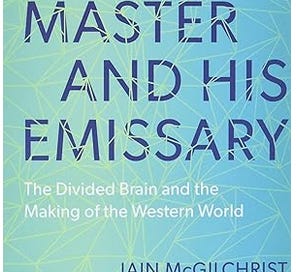Since you can’t throw a rock without hitting AI these days, I’ve been reading a ton lately on regular old human “intelligence” and one book really got my noodle cooking, so I’m gonna share for the class….
This book was a sea-change event for me. Main takeaways - the brain has two different methods for engaging the world, and they are associated with the big crease in your brain which separates, and connects, the left and right hemispheres.
THE RIGHT BRAIN - is the holistic, Gestalt, big picture, irrational side of thinking. Prefers living things, is associated with understanding themes and context, poetry, metaphor, music.
THE LEFT BRAIN - is the detail-oriented, calculative, procedural, rational side of thinking. Prefers inanimate objects and machines, associated with content and particulars, prose, numbers, and abstraction.
What was a main theme of the book is how we need both sides of the brain to pull off human intelligence, taking in the world as a whole (right brain) then processing details (left brain) then sending it all back to the right brain for intuition/understanding/knowledge. We need and use the whole brain to live in the real world. However, dopamine connections between the hemispheres, when mixed with dominant engagement with a specific hemisphere, can end up rewiring a brain to prefer one side over the other. The emissary overpowers the master.
This happens because the way we attend to the world, creates the world. McGilchrist summarizes this in a pithy manner; “The world appearing as shit doesn’t cause a person to become depressed, but rather depression causes the world to appear shitty.”
“Things change according to the stance we adopt towards them, the types of attention we pay to them, the disposition we hold in relation to them.”
Our search for defining what processes and computations are involved in human intelligence/consciousness, misses how we do it. We are obsessed with defining consciousness as something apart from us, when it is in fact, us.
“The fundamental problem in explaining the experience of consciousness is that there is nothing else remotely like it to compare it with: it is itself the ground of all experience. There is nothing else which has the ‘inwardness’ that consciousness has.”
“We are not sure, and could never be sure, if mind, or even body, is a thing at all. Mind has the characteristics of a process more than a thing: a becoming, a way of being, more than an entity. Every individual mind is a process of interaction with whatever it is that exists apart from ourselves according to its own private history.”
One of the most compelling arguments in the book is that we shape the world to fit our dominant way of thinking, which coincides with a preferred hemisphere.
The Renaissance was associated with the right hemisphere, and the industrial revolution with the left. And since that time, we have shaped and conformed our physical/social realities and financial/organizational systems to be in line with the left hemisphere, resulting in industrialized populations that have little choice but to prefer rationality, machines, logic, and straight lines.
We are increasingly existing in a left-hemisphere dominant world, where everything needs to be broken apart, objectified, calculated, correlated with value creation, unambiguous, and predictable through probabilities. The world can, and must, be broken down and understood through the parts.
And yet we LIVE in a subjective world with no straight lines, within complex, dynamic systems, filled with ambiguity, randomness, and holistic interaction. The world needs to be understood in a way that mirrors our lived experience of it; as a whole, and not just outputs of calculated processes.
The answer is to recalibrate our understanding of how human excellence and natural intelligence is defined, protect areas where cross-hemispheric cooperation (the only way human brains work in the real world) is exalted, and to bring the creative right hemisphere, and it’s resultant world-view and manner of engagement, up in stature with the calculating left, and blend/bake-in the two inseparable approaches into our societies and infrastructures.




